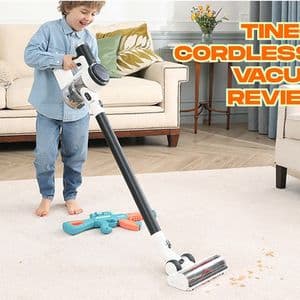Why Stairs Need Special Cleaning Attention
Stairs often collect more dirt than flat flooring because they are high-traffic areas. Shoes track in dust, pet hair accumulates, and the edges trap debris. Unlike flat surfaces, the uneven structure of steps makes cleaning challenging.
This is why many homeowners find regular upright vacuums impractical for stairs. The weight, cord length, and awkward maneuvering create unnecessary hassle. A smaller, more agile vacuum becomes the obvious solution.
The Advantages of Using a Small Vacuum for Stairs
One of the biggest advantages is portability. Small vacuums are lightweight, making it easy to carry them up and down without strain. Their compact size also allows you to reach tight spots like stair corners, risers, and edges.
Another advantage is efficiency. A small vacuum often has specialized attachments designed to improve cleaning precision. Crevice tools, brushes, or motorized heads can make a big difference in removing embedded dust.
Comparing Small Vacuums with Traditional Models
Large upright or canister vacuums may be powerful, but they are not designed with stair cleaning in mind. They require dragging a heavy base or managing a long hose, which can be inconvenient.
In contrast, a small vacuum streamlines the process. It may not have the same dust-bin capacity, but the trade-off in convenience and flexibility often outweighs this limitation for stair-specific cleaning.
Features That Matter Most
When selecting a small vacuum for stairs, a few features stand out:
Lightweight Design
The lighter the vacuum, the easier it will be to use on stairs. Carrying heavy equipment not only tires you out but can also be unsafe on elevated steps.
Cordless or Corded
Cordless models provide maximum mobility, but you’ll need to keep an eye on battery life. Corded versions ensure consistent power but may limit reach if the cord is short.
Attachments and Tools
Crevice tools, upholstery brushes, and mini motorized nozzles enhance cleaning results. These extras can be particularly useful for stairs covered in carpet or fabric.
Filtration System
A good filtration system ensures dust and allergens don’t escape back into your home. HEPA filters are especially effective for households with pets or allergy concerns.
Understanding Different Stair Surfaces
Not all stairs are the same, and the type of vacuum you choose may depend on the surface.
Carpeted Stairs
Carpet fibers trap dust and pet hair, making cleaning more challenging. In this case, the best handheld vacuum for stairs is often equipped with a motorized brush that agitates and lifts debris.
Wooden or Hard-Surface Stairs
Hardwood and laminate stairs need a vacuum that won’t scratch the finish. Soft-bristle attachments or suction-only modes are preferable.
Mixed Surfaces
If your stairs have a combination of carpet runners and exposed wood, versatility in suction settings and accessories will be important.
Benefits Beyond Stairs
While these devices shine on stairs, they are not limited to that task. A handheld vacuum cleaner for stairs is also useful for cleaning car interiors, furniture, or small spills around the house. Its versatility makes it a practical tool for everyday cleaning challenges.
Safety Considerations When Vacuuming Stairs
Stair cleaning can pose safety risks if not done carefully. Always keep one hand free for balance when possible, and avoid overextending with a heavy vacuum. Small vacuums reduce these risks by being lighter and easier to handle.
Tips for Effective Stair Cleaning
Want the best results without extra effort? Follow these tips:
-
Start from the top of the staircase and work downward to prevent re-soiling.
-
Use short strokes to lift embedded dirt from carpets.
-
Empty the dust container frequently to maintain suction power.
-
Incorporate stair cleaning into your weekly routine to avoid buildup.
Environmental and Health Benefits
A cleaner staircase isn’t just about appearances. Dust and allergens tend to accumulate where airflow is limited. Regular cleaning with a dedicated hand vacuum for stairs reduces allergens, improves indoor air quality, and contributes to a healthier living space.
Conclusion
Stairs require more attention than many realize, and using the right vacuum makes all the difference. A small vacuum for stairs offers portability, precision, and efficiency, making a once-tedious task easier and faster.
By focusing on the right features, matching your vacuum to stair materials, and applying smart cleaning practices, you can keep your staircase looking clean while reducing effort. In the end, a small vacuum is not just a tool—it’s a practical solution that transforms stair cleaning into a manageable routine.










